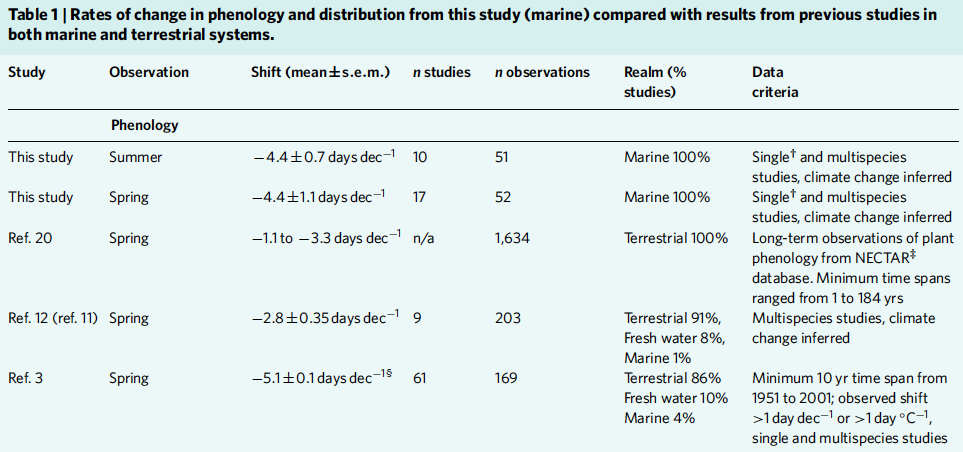An NCEAS working group I was a minor participant in has an important new paper out in Nature Climate Change (Poloczanska et al 2013 PDF).
Summary: We synthesized all available studies of the consistency of marine ecological observations with expectations under climate change. This yielded a metadatabase of 1,735 marine biological responses for which either regional or global climate change was considered as a driver. Included were instances of marine taxa responding as expected, in a manner inconsistent with expectations, and taxa demonstrating no response. From this database, 81–83% of all observations for distribution, phenology, community composition, abundance, demography and calcification across taxa and ocean basins were consistent with the expected impacts of climate change. Of the species responding to climate change, rates of distribution shifts were, on average, consistent with those required to track ocean surface temperature changes. Conversely, we did not find a relationship between regional shifts in spring phenology and the seasonality of temperature. Rates of observed shifts in species’ distributions and phenology are comparable to, or greater, than those for terrestrial systems.
This study is a milestone in research on how greenhouse gas emissions / ocean warming are affecting marine life. It also provides evidence that the oceans are warming. Climate change deniers often fuss about the imperfection of temperature data; however, the biological responses of plants and animals provides equally compelling evidence of changes in temperature. We can predict how organisms will respond to warming or cooling based on a number of disciplines, including biophysics, ecology, paleontology (the fossil record), and physiological ecology.
Take home finding
We found that all organisms for which data is available (marine mammals, sea birds, turtles, fishes, sharks, squid, plankton, invertebrates, mangroves, seagrasses, and seaweeds) in general have responded as predicted to ocean warming. Responses include shifts in the geographic distribution of populations (to higher, cooler latitudes), change in phenology, organismal fitness, population abundance, and community structure.
 Figure 1. Global distribution and regional location of marine ecological climate-impact studies. Observed responses (n=1,735) of marine organisms to climate change from 208 single- and multispecies studies showing responses that are consistent with climate change (blue n=1,092), opposite to those expected (red n=225) or are equivocal (yellow n=418). Each circle represents the centre of a study area. Where points fall on land, it is because they are centroids of distribution that surround an island or peninsula. Pie charts show the proportions within regions bounded by red squares and in the Mediterranean Sea; numbers indicate the total (consistent, opposite plus equivocal) observations within each region.
Figure 1. Global distribution and regional location of marine ecological climate-impact studies. Observed responses (n=1,735) of marine organisms to climate change from 208 single- and multispecies studies showing responses that are consistent with climate change (blue n=1,092), opposite to those expected (red n=225) or are equivocal (yellow n=418). Each circle represents the centre of a study area. Where points fall on land, it is because they are centroids of distribution that surround an island or peninsula. Pie charts show the proportions within regions bounded by red squares and in the Mediterranean Sea; numbers indicate the total (consistent, opposite plus equivocal) observations within each region.
How we did it
We didn’t do any field work; this was a synthetic study. Instead, we got together four times at NCEAS for a week and argued, debated, collected data and studies, analyzed data, wrote the paper, analyzed the data again, etc. Add to that many thousands of emails and dozens of group video conferences. It wasn’t glamorous but it was a ton of work. This is what an NCEAS working group looks like:
 Yup; a bunch of scientists with laptops and an internet connection. Are you sure you want to be a marine biologist?
Yup; a bunch of scientists with laptops and an internet connection. Are you sure you want to be a marine biologist?
We spent countless hours figuring out how to do this. And there was intense debate and some unhappy participants. It was incredibly rigerous in ways that climate change deniers couldn’t image and wouldn’t believe. (Scientists LOVE to play devils advocate). The peer review process was also really really tough. The manuscript was rejected by Science and went through a number of rounds of peer review at NCC.
Download the PDF here, go here for a nice summary by the lead authors, and here for the NCEAS press release.

Leave a Reply